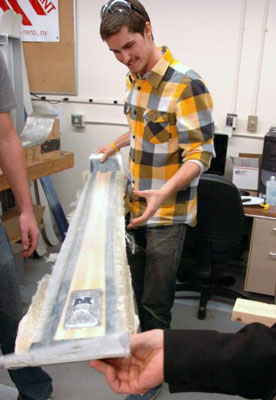| Posted: December 14, 2009 |
New curriculum mixes nanotechnology and skiing |
|
(Nanowerk News) Nanotechnology seems a daunting subject, but for mechanical engineering students at the University of Nevada, Reno, it has taken on a real world approach – in Ski Building 101.
|
|
"Yes, we're going to make skis. No, it's not really Ski Building 101," said Kam K. Leang, the faculty member and principal investigator for a project to further integrate nanotechnology into the undergraduate curriculum at the University.
|
 |
| Students in a mechanical engineering design class at the University of Nevada, Reno remove from the ski press a new ski with a novel vibration dampening design. (Photo by Mike Wolterbeek, University of Nevada, Reno)
|
|
Leang and two colleagues at the University, Jonghwan Suhr and John Cannon, aim to prepare 21st century mechanical engineers at the University to meet the emerging challenges of nanotechnology using a top-down approach where the first important step is to excite them about the technology.
|
|
"We want students to get enthused about mechanical engineering, to see the possibilities and potential of nanotechnology," Leang said.
|
|
Leang, who's been building skis for more than five years in his garage and offers web-based instructions on ski building, has plans for the students to use innovative materials and creative technologies to build something extraordinary.
|
|
"It may not be p-tex, layers of standard materials and steel edges," he said. "We'll integrate nanomaterials into the construction to improve performance and use the student's skills in mechanical engineering to be inventive with ski design."
|
|
"We've built a ski press and a couple pairs of prototype skis," he said. "I expect students will have something remarkable to ski on before the end of the ski season."
|
|
The class, which was divided into two groups, has designed two sets of skis. One uses a honeycomb-type box containing tiny metal balls, called a particle dampener, on the end of the ski to help dissipate energy and lessen the vibrations skiers feel while skiing down the slopes. The other set of skis folds to a convenient size that can fit in a car trunk or even in carry-on luggage at airports.
|
|
As fun as it may be, the curriculum isn't just for building skis. Practical, easy-to-relate-to macro-scale applications such as aerospace structures and wind-energy turbine blades will also be introduced into sophomore- and junior-level courses. The technical engineering challenges and need for improving functionality of all of these applications will be presented and then linked to solutions offered by nanotechnology.
|
|
To further reinforce the concepts, a suite of capstone-level design projects which includes nanocomposite-based wind-energy turbine blades and snow skis will be developed for students entering their senior year of study after being introduced to these applications in previous years.
|
|
"I'm developing the teaching modules for dissemination to other universities such as in Vermont, Colorado, Utah and other ski towns with engineering programs nearby," Leang said. "I envision a competition like the annual concrete canoe races where we will all design and manufacture our skis under a set of rigorous yet creative parameters and then race them."
|
|
Leang will work closely with Jonghwan Suhr, co-principal investigator, nanomaterials expert and faculty member of the mechanical engineering department, and John Cannon, co-principal and a faculty member in the University's education department to develop the new curriculum.
|
|
The new Energy Efficient Systems and Dynamic Structures mechanical engineering curriculum is made possible through a $200,000 grant through the National Science Foundation's Nanotechnology Undergraduate Education in Engineering program.
|

